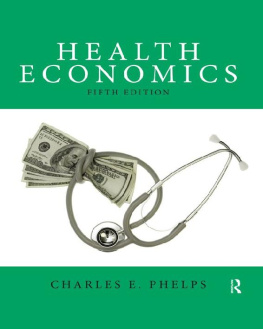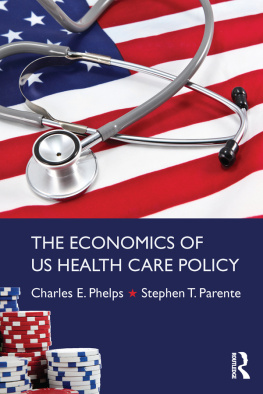Charles E. Phelps - Health Economics
Here you can read online Charles E. Phelps - Health Economics full text of the book (entire story) in english for free. Download pdf and epub, get meaning, cover and reviews about this ebook. year: 2016, genre: Science. Description of the work, (preface) as well as reviews are available. Best literature library LitArk.com created for fans of good reading and offers a wide selection of genres:
Romance novel
Science fiction
Adventure
Detective
Science
History
Home and family
Prose
Art
Politics
Computer
Non-fiction
Religion
Business
Children
Humor
Choose a favorite category and find really read worthwhile books. Enjoy immersion in the world of imagination, feel the emotions of the characters or learn something new for yourself, make an fascinating discovery.
- Book:Health Economics
- Author:
- Genre:
- Year:2016
- Rating:5 / 5
- Favourites:Add to favourites
- Your mark:
- 100
- 1
- 2
- 3
- 4
- 5
Health Economics: summary, description and annotation
We offer to read an annotation, description, summary or preface (depends on what the author of the book "Health Economics" wrote himself). If you haven't found the necessary information about the book — write in the comments, we will try to find it.
Health Economics — read online for free the complete book (whole text) full work
Below is the text of the book, divided by pages. System saving the place of the last page read, allows you to conveniently read the book "Health Economics" online for free, without having to search again every time where you left off. Put a bookmark, and you can go to the page where you finished reading at any time.
Font size:
Interval:
Bookmark:
FIFTH EDITION

CHARLES E. PHELPS
University of rochester

First published 2013, 2010, 2003, 1997 by Pearson Education, Inc.
Published 2016 by Routledge
2 Park Square, Milton Park, Abingdon, Oxon OX14 4RN
711 Third Avenue, New York, NY, 10017, USA
Routledge is an imprint of the Taylor & Francis Group, an informa business
Copyright 2013, 2010, 2003, 1997 Taylor & Francis
All rights reserved. No part of this book may be reprinted or reproduced or utilised in any form or by any electronic, mechanical, or other means, now known or hereafter invented, including photocopying and recording, or in any information storage or retrieval system, without permission in writing from the publishers.
Notice:
Product or corporate names may be trademarks or registered trademarks, and are used only for identification and explanation without intent to infringe.
Credits and acknowledgments borrowed from other sources and reproduced, with permission, in this textbook appear on page 523.
Cover Designer: Suzanne Duda
ISBN-13: 978-0-13-294853-1 (hbk)
Library of Congress Cataloging-in-Publication Data
Phelps, Charles E.
Health economics / Charles E. Phelps. 5th ed.
p. ; cm. (Pearson series in economics)
Includes bibliographical references and index.
I. Title. II. Series: Pearson series in economics.
[DNLM: 1. Economics, MedicalUnited States. 2. Financial Management, HospitaleconomicsUnited States. 3. Health Policy
economicsUnited States. 4. Insurance, HealtheconomicsUnited States. 5. Marketing of Health Serviceseconomics
United States. W 74 AA1]
338.473621dc23
2012000860
TO DALEOUR TIME HAS JUST BEGUN ONCE AGAIN.
As with previous editions, this edition revises and updates all data tables where new data are available. The advent of the Patient Protection and Affordable Care Act (PPACA) in 2010 has led to changes in many chapters of Health Economics , most notably in the organization and focus of . However, rather than just appending a discussion of the PPACA at the end of the book, the fifth edition integrates PPACA issues (as appropriate) throughout the book.
- integrates the PPACA into the overall market equilibrium analysis.
- discusses key requirements in the PPACA, including the requirement that all people in the U.S. must have health insurance coverage, the requirement that employers provide health insurance for their employees, and the importance of the PPACA rule eliminating the use of pre-existing conditions in health insurance underwriting.
- also discuss a new health care delivery model envisioned in the PPACAthe Accountable Care Organization.
- expands the discussion of regulated prices for hospital care to include Medicares new linkage of outcomes of care to reimbursement and the encouragement of Accountable Care Organizations, both facets of the PPACA legislation.
- summarizes the entire PPACA and expands the previous economic analysis of universal insurance in the U.S. to include what options are available to address each issue, and how the PPACA actually dealt with the key issues surrounding implementation of universal insurance coverage.
Other significant changes to this edition are:
- expands the discussion of cost-effectiveness analysis, including (in addition to a discussion of Quality-Adjusted Life Years) a new analysis of the Disability Adjusted Life Years (DALY) measure that is used by the World Bank, the World Health Organization, and many European nations.
- explores physician practice ownership patterns, taking note of recent changes such that over half of all physician practices are now owned by hospitals.
- expands the discussion of International Medical Graduates including new data and discussion that links together IMG certification and quality and medical resident fill rates.
- extends the discussion of nursing practice, including a new analysis of internationally trained nurses and their role in the U.S. nursing market.
- explores the analysis of the tax subsidy to health insurance by introducing explicitly the share of health insurance premiums paid by employers into the analysis and new data and forecasts of the extent of the tax expenditure attributed to the exclusion of employer paid health insurance from the tax base.
- introduces new estimates of the insurance loading fee by employer group size, using the first firm estimates of this relationship in the literature.
- expands and adds new data on the discussion of the market shares held by different types of health insurance plans.
- examines the changes in the Medicare Part B deductible over time.
- adds a new discussion about the extent of enrollment in Medicare Advantage (Part C) programs as an alternative to traditional Medicare coverage.
- explores ambulatory surgery and its effect on hospital occupancy, as well as an expanded discussion of hospice use as an end-of-life alternative to hospitalization.
- adds a new discussion about the relationship between quality of care and negligence lawsuits.
- approaches the topic of transfusion-related illnesses to discuss the extent of this externality in a wide set of nations, rather than focusing wholly on the United States.
The study of health economics is becoming more important and more useful. The health care sector continues to grow in size, both in absolute dollars and as a portion of the overall economic activity of the United States. In terms of employment, now about one person of six in the country is employed in the health care sector.
The governments role in health care has become increasingly important through the years, beginning with the founding of the U.S. Public Health Service in 1798. Many people point to the 1965 creation of Medicare and Medicaid as a landmark step in the governments role in health care. In 2010, however, sweeping new legislation heightened the governments role in health care even morethe Patient Protection and Affordable Care Act (PPACA), sometimes referred to in shorthand as the Affordable Care Act. This edition of Health Economics contains numerous new analyses of issues created or highlighted by passage of the PPACA. Readers will find these analyses throughout the book.
The PPACA does not bring legislative change to a halt. Indeed, as this fifth edition goes to press, numerous issues remain unsettled regarding the most basic structures built into the PPACA. Perhaps most important are legal challenges to the very core of the Actthe requirement (mandate) that individuals obtain health insurance coverage of at least a minimum level as defined in the Act. Numerous lawsuits arose shortly after President Obama signed the PPACA into law, most of them challenging the constitutional validity of the individual mandate. Numerous lawsuits challenged the constitutionality of the PPACA, with conflicting rulings from several Circuit Courts of Appeals. As one would expect in such a situation, the Supreme Court accepted certiori on these cases in the autumn of 2011, as this edition went to press. A ruling is expected before the 2012 summer recess of the Supreme Courtafter the publication of this edition.
Readers of this text will find analyses of many of the facets of the PPACA as it was crafted. As the legal landscape changes, this background should allow the reader to understand how the environment may shift in the future, and readers should be able to use the tools and approaches contained in this book to understand the conse quences of various changes. Indeed, readers will find that even the core legal challenge to the PPACAs individual mandate can be analyzed using key economic issues examined throughout this textbook, including understanding how insurance markets work and game-theoretic approaches to understanding how they would work in various alternative legal settings.
Font size:
Interval:
Bookmark:
Similar books «Health Economics»
Look at similar books to Health Economics. We have selected literature similar in name and meaning in the hope of providing readers with more options to find new, interesting, not yet read works.
Discussion, reviews of the book Health Economics and just readers' own opinions. Leave your comments, write what you think about the work, its meaning or the main characters. Specify what exactly you liked and what you didn't like, and why you think so.











